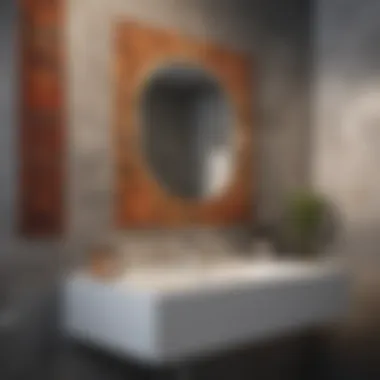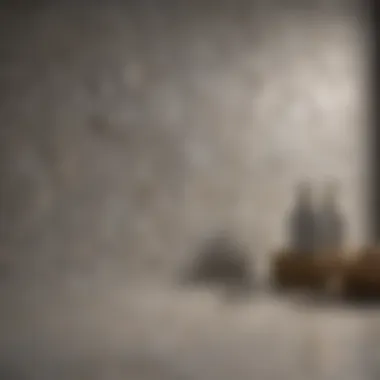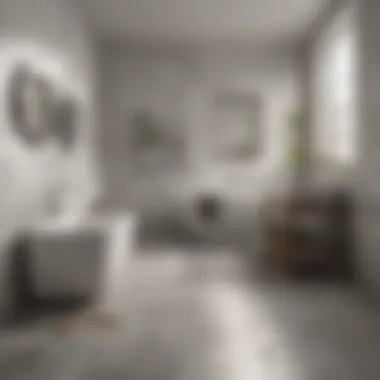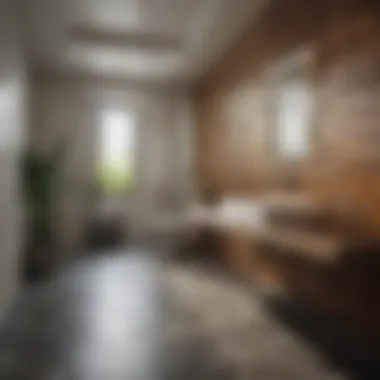Innovative Bathroom Tile Cover-Up Techniques


Intro
Bathroom renovations are not solely about aesthetics but also about practicality. Tile cover-ups offer an efficient and often cost-effective way to refresh one’s space. Homeowners often face the challenge of outdated or worn tiles that detract from the overall look and feel of the bathroom. This article aims to pave the way for better decision-making regarding tile cover-ups. We will explore various techniques, materials, design considerations, and the current trends that are defining the bathroom space today.
The relevance of this topic is heightened by the increasing emphasis on personalizing bathroom environments. Many homeowners seek to create serene settings that reflect their tastes while maintaining functionality. Understanding various cover-up techniques, from painting to installing new overlays, provides valuable insights for those embarking on such projects.
Preface to Bathroom Tile Cover-Ups
In the realm of home renovation, bathroom tile cover-ups play a pivotal role. As homeowners seek to refresh their spaces, understanding the various methods of concealing outdated or damaged tiles becomes essential. This section will explore the importance of tile cover-ups, focusing on their benefits and considerations. The bathroom, often considered a sanctuary, can transform significantly with the right updates, making it vital to choose the right approach to tile cover-ups.
Understanding the Concept
The concept of tile cover-ups revolves around concealing existing tiles rather than fully replacing them. This method allows homeowners to achieve an updated look with less time and disruption. A key element of this technique is its ability to enhance the overall aesthetics of a bathroom without undertaking a complete remodel. Taransitioning from tired surfaces to fresh visuals can be accomplished through various methods, making it a practical solution for many.
Reasons for Tile Cover-Ups
Cosmetic Updates
Cosmetic updates are one of the primary motivations for tile cover-ups. Homeowners often desire a change in style or a way to modernize their bathrooms. A fresh look can add value to a home while also improving the owner's enjoyment of the space. Key characteristic of cosmetic updates is the diverse variety of materials and designs available. This flexibility allows for customization, catering to both contemporary and traditional tastes. However, it is important to ensure that the chosen materials will bond well with the existing surface and withstand moisture exposure.
Damage Concealment
Damage concealment serves to address unsightly tiles that may detract from a bathroom's appeal. Cracks or stains can significantly lower the aesthetic value of a space. Homeowners often opt for tile cover-ups when faced with such damage, creating a seamless appearance while avoiding costly replacements. Key characteristic of damage concealment lies in its efficiency and effectiveness in addressing visible imperfections. It offers a beneficial alternative, especially when the existing tiles are generally sound but require touch-ups in specific areas. Nonetheless, damage beneath the surface must still be considered, as structural issues may arise if left untreated.
Cost Efficiency
Cost efficiency is a significant advantage of opting for tile cover-ups. Replacing entire floors or wall tiles can be expensive and time-consuming. By covering existing tiles, homeowners can save on labor costs and materials. This method is not only effective in saving money but also in reducing waste. Key characteristic of cost efficiency relates to how it enables budget-conscious renovations without compromising design. While it offers substantial savings, it's crucial to evaluate the longevity of the materials used in the cover-up process; both durability and maintenance must be factored into long-term cost assessments.
By understanding the multifaceted reasons for tile cover-ups, homeowners can make informed decisions that enhance aesthetics, conceal damage, and maintain budget constraints.
Assessing Your Bathroom's Current Condition
Assessing your bathroom's current condition is a vital step before you consider any tile cover-up strategies. This process helps you understand the underlying aspects of your bathroom that might influence your renovation plans. There are several key elements to examine that can provide insights into your project's direction. Whether you wish to conceal worn tiles or refresh the overall look, this assessment lays a strong foundation for decision-making.
Evaluating Existing Tiles
When evaluating existing tiles, start by closely inspecting their surface and structure. Look for wear and tear signs, like cracks or chips, indicating potential issues beneath the surface. Understanding the type of tiles currently installed is also essential. For instance, ceramic and porcelain tiles differ in durability and installation methods, which might affect your cover-up choices.
Moreover, consider the grout lines. If the grout is stained or deteriorating, it could detract from the overall aesthetic, making a tile cover-up necessary. Ensure you check for any moisture-related issues as well. This might involve looking for discoloration or damage in surrounding areas, signaling the potential for mold growth. A thorough evaluation not only helps in choosing the right covering method but also helps to save time and resources in addressing underlying problems.
Identifying Structural Concerns
Identifying structural concerns is another key aspect of assessing your bathroom before a tile cover-up. Issues like water damage or compromised flooring should not be overlooked. If the subfloor is compromised, simply covering tiles may lead to larger problems down the line. Inspect areas around fixtures, like sinks and toilets, where leaks are more common.
Additionally, examine walls for any signs of dampness or instability. Sometimes tile and wall structures are more fragile than they appear. Using a moisture meter can provide a clearer picture of moisture levels hidden within your walls or flooring. If you notice persistent dampness, this may warrant further investigation into your plumbing and water drainage systems.
Addressing these structural concerns ensures that your renovation is not just cosmetic but also protective, ultimately enhancing the longevity of your bathroom. Keeping an eye on the essential details will facilitate a more efficient tile cover-up process in the future.
Remember: A sound structure is the backbone of any successful renovation. Ignoring foundational issues can lead to increased costs in the long run.
Tile Cover-Up Methods
Bathroom tile cover-up methods play a critical role in the renovation process. They can transform outdated tiles and enhance a space’s overall aesthetic while addressing practical concerns. Selecting the right method is essential for achieving lasting results. Each technique offers varied benefits and drawbacks, impacting the choice made by homeowners. These approaches range from overlaying new tiles to paint applications, each warranting careful consideration.
Overlaying New Tiles
Pros and Cons


The overlaying of new tiles is a favored method for many homeowners. One significant pro is the ability to maintain the existing tile structure without an extensive demolition process. This can save both time and labor costs. Additionally, new tiles allow for a fresh look and can align with current design trends. However, a con is the extra weight added to the floor and walls, which may be a concern in certain cases. The substrate must be strong enough to handle this additional weight.
Installation Process
The installation process for overlaying new tiles involves several crucial steps. First, the old tiles must be cleaned and inspected for damage. Then, leveling compounds may be applied if there are discrepancies in the surface. The new tiles are laid out carefully, ensuring proper alignment. One notable advantage of this method is the variety of tile options available, from ceramic to natural stone, each bringing distinct benefits in terms of durability and appearance. However, the need for precise measurements can add complexity to the installation.
Using Peel-and-Stick Products
Advantages of Peel-and-Stick
Peel-and-stick products are gaining popularity for their simplicity and instant gratification. The primary advantage is the ease of use. Homeowners can often complete the installation without professional help. This method is also ideal for renters or those who want a temporary solution. The range of designs available means that homeowners can choose a look that matches their personal style.
Limitations and Considerations
Despite their advantages, peel-and-stick tiles do present limitations. The adhesive may not bind well in high moisture areas, such as bathrooms. This can lead to peeling over time, especially if proper surface preparation is not followed. Additionally, they are generally less durable than traditional tiles, making them a less ideal choice for long-term solutions.
Paint on Tiles
Choosing the Right Paint
Painting tiles is another method that can dramatically change the bathroom's appearance. Choosing the right paint is critical. Specialty paints designed for tiles provide the necessary durability and water resistance required in a bathroom environment. This method is cost-effective and allows for a wide palette of colors. However, the choice of paint impacts aesthetics and longevity, necessitating careful selection.
Application Techniques
Application techniques are crucial to many successful paint jobs on tile. Proper surface preparation is vital, including cleaning and possibly sanding the tiles to promote adhesion. It is important to apply multiple coats for an even finish, allowing adequate drying time between them. An advantage of this method is the potential for creativity, allowing homeowners to engage in detailed design while bringing new life to their existing tiles. Yet, the effort involved in application might deter some homeowners, who prefer simpler methods.
Materials Considerations
Choosing the right materials for bathroom tile cover-ups is critical for achieving a successful renovation. The materials impact not only the appearance of the space but also its durability and functionality. Homeowners must evaluate their options carefully, weighing the benefits and drawbacks associated with different types of tiles, adhesives, and preparation materials. Each choice plays a vital role in the long-term satisfaction of the finished project.
Tile Options for Cover-Ups
Porcelain vs. Ceramic
Porcelain and ceramic tiles are popular choices for bathroom renovations due to their robust nature and aesthetic versatility. Porcelain tiles are denser and often considered more durable than their ceramic counterparts. They resist moisture and are ideal for spaces that regularly encounter water. On the other hand, ceramic tiles offer a wider variety of styles and colors, typically at a lower price point.
When choosing between porcelain and ceramic, consider the unique characteristics. Porcelain’s density makes it less prone to cracking, while ceramic’s cost-effectiveness can be appealing for larger areas. However, porcelain tiles can be heavier, potentially complicating installation.
Natural Stone
Natural stone tiles, such as granite or marble, elevate the aesthetic of a bathroom with their unique patterns and textures. They are luxurious but can come at a high cost. Their main advantage is their beauty and authenticity, but maintenance is crucial as they require sealing to prevent moisture penetration and stains.
Natural stone offers a distinct look that is hard to replicate with manufactured tiles. However, the need for ongoing upkeep can be a significant downside, especially in moisture-rich environments. Understanding these dimensions helps in making informed choices.
Adhesives and Prep Materials
Choosing the Right Adhesive
Selecting appropriate adhesives is essential for a durable cover-up. The right adhesive ensures that the tiles will bond effectively, maintaining integrity over time. For instance, thin-set mortar is widely used for its versatility and effectiveness in various conditions. If you are working with materials like natural stone, the adhesive’s compatibility with the tile type becomes paramount.
Using the right adhesive could prevent tiles from loosening or cracking due to shifts or moisture impact. Different adhesives may have different drying times and temperature resistance. Weighing these factors is a necessity in this process.
Surface Preparation Techniques
Preparing the surface before laying new tiles is a critical step in a successful renovation. Surface preparation techniques ensure that the new tiles adhere properly and last longer. This may involve leveling the floor, cleaning existing tile surfaces, or applying a primer to enhance bond strength.
The main feature of proper preparation is that it helps prevent premature failure of the installation. Neglecting this aspect can lead to complications such as tiles lifting or unevenness over time. Thus, investing time in this step pays dividends in the long run.


Design Considerations
Design considerations play a significant role in the process of selecting tile cover-ups. The overall goal of any renovation is to create a space that is not only functional but also visually appealing. These considerations can greatly impact the aesthetics and experience of the bathroom. Thoughtfully chosen elements can transform a mundane area into a stylish retreat.
Color and Aesthetic Choices
Current Color Trends
Current color trends in bathroom design are essential to understand when planning tile cover-ups. Shades such as soft greys, pastels, and warm neutrals are particularly popular right now. These colors create soothing atmospheres that contribute to relaxation and serenity in the bathroom. On the other hand, one can also see a rise in bold colors like navy blue and emerald green, which add a touch of sophistication.
The benefit of following current color trends is more than just aesthetic appeal. Choosing trendy colors can increase the resale value of the home. However, a unique feature of these trends is their versatility; they can be combined or contrasted with different materials and textures, offering many design possibilities. A disadvantage might be that trends change, and what is trendy now could become outdated in a few years.
Texture Options
Texture options have become an important choice in bathroom design. Textures can enhance visual interest and depth in the space. For instance, matte finishes provide a contemporary look, while glossy materials can add brightness and the illusion of space. Incorporating mixed textures can also create an appealing visual narrative.
A key characteristic of texture options is their impact on the overall feel of the room. Textured tiles can help in establishing a cozy and inviting environment. However, one must consider maintenance, as certain textures may show dirt or require more cleaning efforts. Choosing the right texture can significantly enhance the comfort and allure of the bathroom space.
Patterns and Layouts
Popular Tile Patterns
Popular tile patterns can make a strong statement. A variety of patterns, such as herringbone, chevron, and grid, offer distinct looks and feelings in the bathroom. Herringbone, for example, creates a classic and elegant feel, while chevron adds a modern twist.
The key benefit of using popular patterns is their ability to evoke different moods. Many homeowners appreciate the flexibility patterns provide in personalizing their spaces. A potential downside is that intricate patterns might overwhelm smaller bathrooms or require more skill to install properly.
Strategic Layout Considerations
Strategic layout considerations are crucial for optimizing space in bathroom design. The layout can influence the flow and functionality of the area. For instance, large tiles can make a bathroom seem larger, while vertical patterns can create an illusion of height. Layouts should be planned based on the room's dimensions and desired function.
A significant benefit of a well-thought-out layout is improved usability. A poorly planned layout can lead to obstructed movement and an uncomfortable user experience. Thus, taking the time to strategize the tile layout can pay off in enhanced comfort and aesthetic appeal.
Environmental Factors
When considering bathroom renovations, environmental factors play a critical role in shaping the decision-making process. This section explores the significance of sustainability, moisture control, and ongoing maintenance. These factors not only influence the longevity of the tile cover-up but also contribute to overall bathroom health and efficiency. Understanding these aspects is essential for homeowners who aim to create a stylish and responsible space while minimizing environmental impact.
Sustainability Considerations
Eco-Friendly Materials
Using eco-friendly materials in bathroom renovations has gained traction in recent years. These materials come from sustainable sources, which reduces environmental impact. A key characteristic of eco-friendly materials is that they often use lower levels of harmful chemicals. This makes them a popular choice for health-conscious homeowners.
They include recycled glass tiles and sustainably sourced woods. One unique feature is their ability to reduce carbon footprints during production. However, some eco-friendly materials may come at a higher cost than traditional options. This trade-off between sustainability and budget is something to contemplate when planning a renovation project.
Recycling Old Tiles
Recycling old tiles is an important aspect of a sustainable approach to bathroom renovations. One key characteristic of this practice is its contribution to waste reduction. Instead of discarding old tiles, homeowners can repurpose them or use them in new designs. This not only makes renovations more environmentally friendly but also appeals to budget-conscious buyers. A unique feature of recycling is its potential to inspire creativity. Homeowners can create custom mosaic designs with leftover tiles. However, the process might be labor-intensive and require specific skills to ensure a satisfactory finish.
Moisture Control and Maintenance
Moisture control is crucial in bathrooms, where excess humidity can lead to serious issues. Addressing moisture effectively can prevent costly repairs and maintain a comfortable environment. Key considerations include preventing mold growth and ensuring easy maintenance after the tile cover-up.
Avoiding Mold and Mildew
Avoiding mold and mildew is essential for overall bathroom health. A primary characteristic of mold prevention is ensuring proper ventilation. Improving airflow can greatly reduce moisture buildup, thus limiting these potential threats. This makes it a beneficial choice for homes with high humidity levels. A unique feature of mold prevention strategies is the installation of exhaust fans. These fans can significantly enhance air circulation in bathrooms. However, neglecting proper ventilation may still lead to mold growth, highlighting the importance of consistent maintenance even after tile cover-ups.
Post-Application Care
Post-application care is another fundamental aspect of maintaining a newly renovated bathroom. Proper care ensures that the tile cover-ups remain in top condition. One key characteristic of post-application care involves routine cleaning. Regular maintenance helps to avert damage or discoloration of tiles. This makes consistent upkeep a popular choice among homeowners aiming to prolong the life of their renovations. A unique feature of post-application care is sealing grout lines to prevent staining, which adds an additional layer of protection. Though this strategy requires a one-time investment of time and resources, the long-term benefits often outweigh the initial challenges.


By considering environmental factors in your renovation, you can create a space that is not only beautiful but also sustainable and healthy.
Budgeting for a Tile Cover-Up
Budgeting for a tile cover-up is a crucial component in any renovation process. It provides a clear framework for the scope and direction of the project. Homeowners need to balance their desires for aesthetics with practical financial considerations. A well-planned budget helps prevent overspending and ensures that the project remains economically viable.
Understanding the variations in costs associated with different cover-up techniques can influence choices significantly. Tiles, adhesives, and labor can vary greatly in price, impacting overall expenditure. Therefore, establishing a budget that accounts for every aspect of the project is important to a successful tile renovation.
Estimating Costs
Estimating costs is an essential first step in budgeting for a tile cover-up. Factors such as the area size, type of materials chosen, and extent of labor required play significant roles in the final costs. For example, using peel-and-stick tiles often proves to be more cost-efficient compared to traditional tile methods that require installation labor and additional materials.
Several estimations should be made:
- Material Costs: Assess the price of the tiles, adhesives, and preparations needed.
- Labor Costs: If hiring professionals, include those fees within the budget.
- Tools and Equipment: Factor in any tools needed for installation if opting for a DIY approach.
Creating a rough estimate of these components can provide a clearer picture of the financial commitment required.
Finding Affordable Options
Finding affordable options is vital for homeowners who want to enhance their bathrooms without breaking the bank. There are multiple avenues to explore that can provide cost savings without compromising quality.
DIY Solutions
DIY solutions are increasingly popular for bathroom tile cover-ups. They allow homeowners to take control of the project, often leading to significant savings on labor costs. One key characteristic of DIY solutions is flexibility. Homeowners can work at their own pace and adjust the project as needed.
Unique features of DIY solutions include:
- Low Cost: The absence of professional labor fees can dramatically reduce costs.
- Personal Satisfaction: Completing the project personally can provide a sense of achievement.
- Customization: Homeowners have the opportunity to personalize every aspect of the cover-up.
However, DIY projects can come with disadvantages such as requiring more time and potentially leading to errors if not executed properly. This necessitates careful planning and maybe some learning.
Shopping Recommendations
Shopping recommendations can lead to more choices and better deals in material selection. Proper guidance on where to buy tiles and tools can ease the financial burden. Key characteristics of shopping recommendations include expert advice and comparative pricing.
Unique features of shopping recommendations are:
- Online Resources: Platforms like Reddit can offer community insights on bargains.
- Discount Stores: Many brick-and-mortar stores have tile sections with clearance items at reduced prices.
- Quality Comparison: Recommendations can assist homeowners in evaluating products based on reviews and experiences of others.
With a solid understanding of local stores and online summations, homeowners can make informed choices that suit their budget, ultimately enhancing their renovation experience.
Closure: Making an Informed Choice
In the realm of bathroom renovations, making an informed choice regarding tile cover-ups is crucial for achieving a satisfying outcome. With numerous techniques available, it is essential to evaluate not only the aesthetic value but also the practical implications of each option. Understanding your specific needs leads to better decision-making, ensuring that the final result aligns with your vision and functional requirements.
Evaluating Your Options
Before proceeding with a cover-up project, it is vital to thoughtfully evaluate the various options at your disposal. This begins with a clear understanding of your bathroom’s current condition. Do you desire a fresh look? Or are you mainly concerned with concealing damage?
- Overlaying new tiles might be suitable if you want a durable solution that enhances aesthetics while covering imperfections.
- Peel-and-stick products are convenient and perfect for those who prefer easy installation. They often serve well for temporary changes.
- Tile paint, while less conventional, can provide a unique solution for those who want to experiment with color without a major commitment.
Consider the materials, costs, and installation complexities associated with each method. Knowing aspects such as longevity, maintenance requirements, and moisture resistance are critical. Your decision should reflect a balance between your budget, style, and the functional demands of your bathroom.
Preparing for Your Project
Preparation is key to a successful bathroom tile cover-up. Gather necessary materials and tools before starting. Assess the area thoroughly to plan out the steps. Here are some important actions to consider:
- Surface Preparation: Ensure that the existing tiles are clean and free from grime or damage.
- Measuring the Space: It’s essential to gather accurate measurements to avoid oversights during installation.
- Material Selection: Decide on tiles or materials based on both aesthetics and practicality. Ensure they fit within your chosen budget.
- Gathering Tools: Not having the right tools on hand can lead to frustration. Prepare all needed tools in advance.
- Timing: Plan your project for a time when you can devote the necessary focus without interruptions.
Proper preparation not only streamlines your process but also enhances the quality of the outcome.
By taking these steps, you position yourself for a smoother process that leads to desirable results. Overall, being well-informed and prepared is the cornerstone of transforming your bathroom successfully, ensuring that every choice made furthers your goals for a tranquil and beautiful space.



